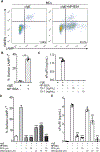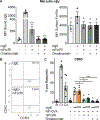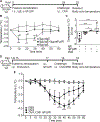The soluble isoform of human FcɛRI is an endogenous inhibitor of IgE-mediated mast cell responses
- PMID: 30030936
- PMCID: PMC8601106
- DOI: 10.1111/all.13567
The soluble isoform of human FcɛRI is an endogenous inhibitor of IgE-mediated mast cell responses
Abstract
Background: The soluble isoform of FcɛRI, the high-affinity IgE receptor (sFcεRI), is a protein of the IgE network with poorly defined functions.
Objective: To define cellular sources and signals that result in the production of human sFcεRI and study its in vivo functions.
Methods: FcεRI-transfected human cell lines (MelJuso), human monocyte-derived dendritic cells (moDCs), and murine bone marrow-derived mast cells (MC) were stimulated by FcεRI cross-linking and release of sFcεRI was analyzed (ELISA, Western Blot). Lysosomal-associated membrane protein 1 degranulation assays and human basophil activation tests (BATs) were used to study IgE-dependent activation. Recombinant sFcεRI (rsFcεRI) was used to assess its role in murine models of anaphylaxis with WT (wild-type) and IgE-/- (IgE-deficient) mice.
Results: Antigen-specific cross-linking of IgE-loaded FcɛRI on MelJuso cells that express the trimeric or tetrameric receptor isoform induced the production of sFcεRI. Using MCs and moDCs, we confirmed that IgE/FcɛRI activation induces sFcɛRI release. We demonstrated that generation of sFcɛRI requires Src phosphorylation and endo/lysosomal acidification. In experimental mouse models, sFcɛRI diminishes the severity of IgE-mediated anaphylaxis. BATs confirmed that, comparable to the anti-IgE monoclonal antibody omalizumab, sFcɛRI is an inhibitor of the human innate IgE effector axis, implying that sFcɛRI and omalizumab potentially inhibit each other in vivo.
Conclusion: sFcɛRI is produced after antigen-specific IgE/FcɛRI-mediated activation signals and functions as an endogenous inhibitor of IgE loading to FcɛRI and IgE-mediated activation. Our results imply, therefore, that sFcɛRI contributes to a negative regulatory feedback loop that aims at preventing overshooting responses after IgE-mediated immune activation.
Keywords: FcεRI; IgE receptor; allergy; mast cell; omalizumab.
© 2018 EAACI and John Wiley and Sons A/S. Published by John Wiley and Sons Ltd.
Conflict of interest statement
Conflicts of interest
The authors confirm that there are no known conflicts of interest associated with this publication and there has been no significant financial support for this work that could have influenced its outcome.
Figures





References
-
- Kraft S, Kinet JP. New developments in FcepsilonRI regulation, function and inhibition. Nature reviews Immunology. 2007;7(5):365–78. - PubMed
-
- von Bubnoff D, Novak N, Kraft S, Bieber T. The central role of FcepsilonRI in allergy. Clinical and experimental dermatology. 2003;28(2):184–7. - PubMed
-
- Gould HJ, Sutton BJ. IgE in allergy and asthma today. Nature reviews Immunology. 2008;8(3):205–17. - PubMed
Publication types
MeSH terms
Substances
Grants and funding
LinkOut - more resources
Full Text Sources
Other Literature Sources
Research Materials
Miscellaneous

